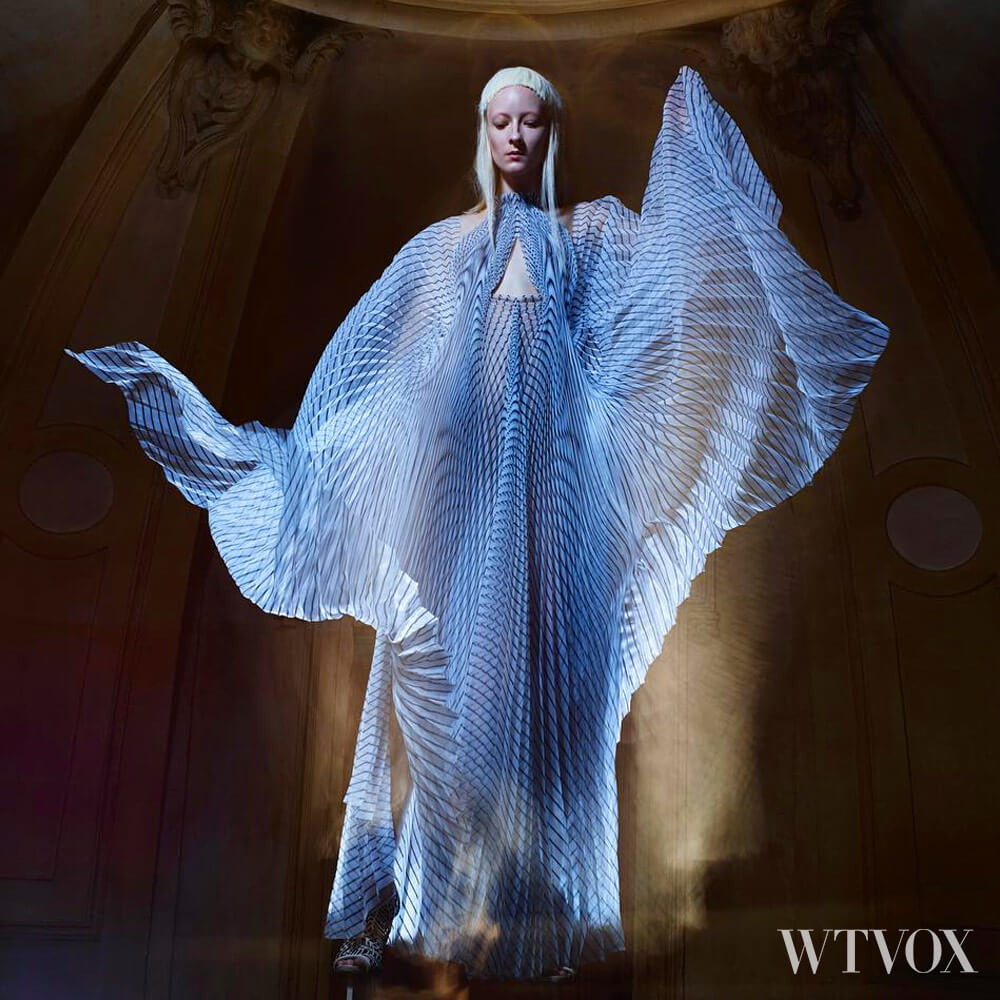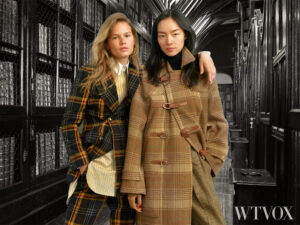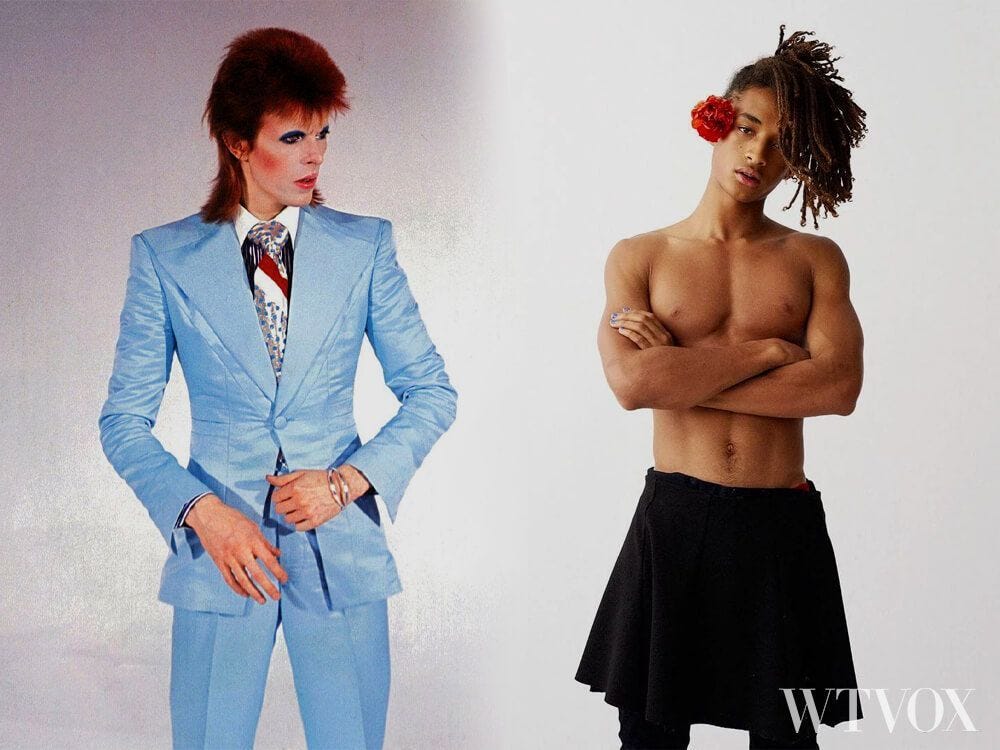When it comes to fashion innovation, consumer adoption, and constant technological development are critical.
As both industries are future-driven and consumer-focused, adoption happens naturally.
But, when it comes to technology, not all developments are suitable for the fashion industry.
From digital influencers to AI and material innovation, are the top 21 fashion innovations of 2020, shaping the future of fashion.
22. Virtual Influencers
Following on the steps of Lil Miquela Sousa, the world’s first virtual influencer and digital supermodel, a new influential virtual persona has emerged: Noonoouri.
Created by the Munich-based designer and creative director Joerg Zuber, this digital persona has become a significant player in the fashion world.
She has over 300,000 Instagram followers and partnerships with major brands such as Dior, Versace and Swarovski.
Just like Miquela, Noonoouri’s Instagram features product placement.
In the past, she ‘pose’ with a bottle of Calvin Klein’s Eternity perfume, receiving over 10,000 likes.
21. Fabric From Seaweed
Algiknit is a company that produces textile and fibres from kelp, a variety of seaweed.
The extrusion process turns the biopolymer mixture into a kelp-based thread that can be knitted, or 3D printed to minimise waste.
The final knitwear is biodegradable and can be dyed with natural pigments in a closed-loop cycle.
20. Biodegradable Glitter
BioGlitz is the world’s first company to produce biodegradable glitter.
Based on a unique formula made from eucalyptus tree extract, the eco-glitter is compostable and biodegradable.
Excellent fashion innovation as it allows for sustainable consumption of glitter without the environmental damage associated with microplastics.
19. Circular Fashion Software
BA-X has created a cloud-based innovative software that interconnects circular design with circular retail models and closed-loop recycling technologies.
The system enables fashion brands to design, sell and recycle garments in a circular model, with minimal waste and pollution.
Clothes are appended an identification tag that links to a reverse supply chain network.
18. Textiles From Trees
Kapok is a tree that grows naturally, without the use of pesticides and insecticide.
Moreover, it is found in arid soil not suitable for agricultural farming, offering a sustainable alternative to high water consumption natural fibre crops such as cotton.
‘Flocus’ is a company that has designed a new technology to extract natural yarns, fillings, and fabrics from kapok fibres.
17. Leather From Apples
Apple pectin is an industrial waste product, often discarded at the end of the manufacturing process.
However, a new technology developed by Frumat allows the use of apple pectin to create sustainable and compostable materials.
The brand uses apple skins to create a leather-like material durable enough to make luxury accessories.
Moreover, this type of vegan apple leathers can be dyed and tanned without toxic chemicals.
16. Fashion Rating Apps
The number of fashion renting apps is on the rise.
These apps are designed to provide ethical ratings for thousands of fashion brands.
These ratings are based on the brands’ impact on people, animals, and the planet.
The rating system aggregates standards, certifications and publicly available data into consumer-ready point scores.
These apps promote transparency across the fashion industry and to allow customers to make conscious purchasing decisions.
15. Biodegradable Polyester
Mango Materials is an innovative company that produces bio-polyester, a form of biodegradable polyester.
The material can be biodegraded in many environments, including landfills, wastewater treatment plants, and the oceans.
The novel material can prevent microfibre pollution and also contribute to a closed-loop, sustainable fashion industry.
14. Lab-Made Fabrics
Technology has finally reached the point where we can re-program the self-assembly of collagen molecules in the lab, and build leather-like fabrics.
The next-generation fabric delivers a more efficient and sustainable alternative to leather without harming animals.
Two companies worth mentioning here are Provenance and Modern Meadow.
13. Monitoring Services
‘Reverse Resources’ is a platform that enables fashion brands and garment manufacturers to address pre-consumer waste for industrial upcycling.
The platform allows factories to monitor, map and measure leftover fabrics.
These scraps become traceable through their following life cycles and can be reintroduced into the supply chain, limiting the use of virgin materials.
12. Knitting Robots
Scalable Garment Technologies Inc. has built a robotic knitting machine linked to a 3D modelling software.
The robot can make custom seamless knit garments.
Moreover, this unique knitting device enables the digitisation of the entire production process and on-demand manufacturing.
11. Rental Marketplaces
Style Lend is an innovative fashion rental marketplace that uses AI and machine learning to match users based on fit and style.
Renting out garments is a new business model that extends the life cycle of clothing and delays from ending in the landfills.
10. Needle-Free Sewing
Nano Textiles is a sustainable alternative to using chemicals to attach finishes onto fabrics.
This innovative material embeds fabric finishes directly into the fabric via a process called ‘cavitation’.
The Nano Textiles technology can be used on a wide range of products such as antibacterial and anti-odour finishes, or water repellency.
Moreover, the system protects consumers and the environment from hazardous chemicals.
9. Fibres From Oranges
The orange fibre is extracted from the cellulose found in discarded oranges during industrial pressing and processing.
The fibre is then enriched with citrus fruit essential oils, creating a unique and sustainable fabric.
8. Bio Packaging
‘Paptic’ is a company that manufactures bio-based alternative packaging materials made from wood.
The resulting material has similar properties of paper and plastic used in the retail sector.
Yet, the material has higher tear resistance than paper and can be recycled alongside cardboard.
7. Nanotechnology Materials
Thanka to ‘PlanetCare’ there’s a microfibre filter that can be integrated into washing machines to capture microplastics before reaching wastewater.
The system is based on water microfiltration, and it works thanks to electrically charged fibres and membranes.
This nanotech technology contributes by reducing microplastics pollution the world’s waters.
6. Digital Runways
Because of COVID-19 and following the cancellation of fashion shows on a global scale, the industry is looking at digital environments.
In the early phase of the outbreak, Tokyo Fashion Week rethought its runway show by streaming concept presentations online, without a live audience.
Inspired by Tokyo’s effort, other cities have turned to technology to communicate with their now ‘stay-at-home’ audience.
A host of other events surrounding the international fashion weeks are also restructuring around the never-ending pandemic.
For example, trade shows have re-established as live online events, and LFW Designer showrooms are now digitised.
5. Clothing Reward Programs
Clothing reward programs are gaining ground fast, be that in “bring them back to recycle” or “wear them longer” aspects.
For example, Tommy Jeans Xplore line comprises a smart-chip technology that rewards customers each time they wear the garments.
All 23 pieces of the line are embedded with a Bluetooth smart tag, which connects to the iOS Tommy Hilfiger Xplore app.
The collected points can be redeemed as discounts on future Tommy products.
4. 3D Printed Sustainable Apparel
The constant R&D in 3D printing took us to a point where we can now print with advanced materials.
Carbon, nickel, alloys, glass, and even bio-inks, are mere formalities.
In the fashion industry, we are seeing growing interest in printing leather and fur-like materials.
3. Fashion Blockchain
Anyone interested in fashion innovation is looking to leverage the power of blockchain technology.
Just like the Internet changed the world as we know it, blockchain technology has the potential to reshape the way businesses procure, manufacture and sell fashion.
Blockchain can create a universe of informational exchanges as perpetual information and experiences we employ, utilise and exploit, every minute and every hour of the day.
2. Virtual Clothes
Superpersonal is a British startup working on an app that allows buyers to try on clothes virtually.
Users feed the app with basic information such as gender, height and weight.
The app creates a virtual version of the user and starts appending digital modelling clothes on the virtual silhouette.
The app was launched at the London Fashion Show in February and is already available for download.
The company also has a commercial version of Superpersonal for retail outlets.
It allows retailers to create personalised shopping experiences for their customers.
1. AI Designers and Stylists
Modern algorithms are increasingly powerful, adaptive and versatile.
In fact, AI makes the next generation of in-store robots appear to possess human-like intelligence.
For example, the London-based Intelistyle has launched an artificial intelligence stylist able to work with retailers and customers.
For retailers, the AI designer can ‘complete looks’ by generating multiple outfits based around a single product.
It can also recommend alternatives for out-of-stock items.
For shoppers, the AI recommends styles and outfits based on body type, hair and eye colour and skin tone.
The AI personal stylist can be accessed on any device, allowing customers a seamless move between online and offline shopping.
Conclusion
Fashion innovation is paramount to commercial value and longevity.
It is critical to how we shape the industry beyond the current crisis.
Fashion innovation can help to replace wasteful materials with sustainable alternatives.
It can end low-paid human jobs, repetitive and dangerous.
Innovative fashion will allow us to function and interact in a digital world.
A world of autonomous cars, smart homes, and connected objects.
There is no way back, not to pre-pandemic fashion and not if we want fashion to remain relevant.
The only way forward is fashion innovation, development and adoption.






